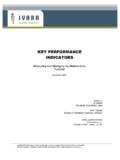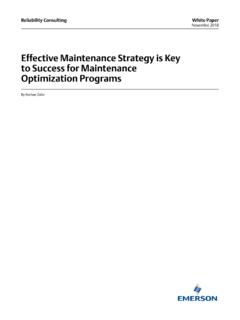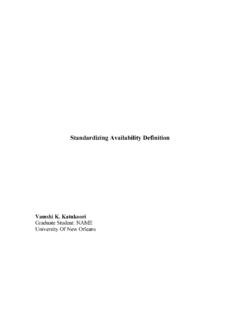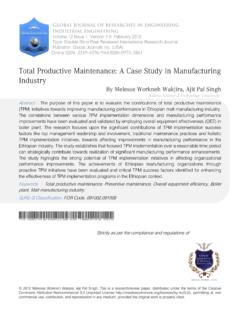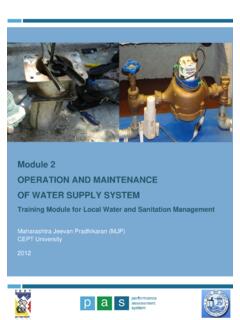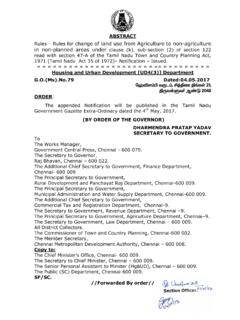Transcription of Agilent 6500 Series Q-TOF LC/MS system
1 Agilent TechnologiesAgilent 6500 Series Q-TOF LC/MS systemMaintenance GuideResearch Use Only. Not for use in Diagnostic 6500 Series Q-TOF LC/MS maintenance GuideNotices Agilent Technologies, Inc. 2011No part of this manual may be reproduced in any form or by any means (including elec-tronic storage and retrieval or translation into a foreign language) without prior agree-ment and written consent from Agilent Technologies, Inc. as governed by United States and international copyright Part NumberG2581-90065 EditionRevision B, December 2011 Printed in USAA gilent Technologies, Stevens Creek Blvd. Santa Clara, CA 95051 WarrantyThe material contained in this docu-ment is provided as is, and is sub-ject to being changed, without notice, in future editions. Further, to the max-imum extent permitted by applicable law, Agilent disclaims all warranties, either express or implied, with regard to this manual and any information contained herein, including but not limited to the implied warranties of merchantability and fitness for a par-ticular purpose.
2 Agilent shall not be liable for errors or for incidental or consequential damages in connec-tion with the furnishing, use, or per-formance of this document or of any information contained herein. Should Agilent and the user have a separate written agreement with warranty terms covering the material in this document that conflict with these terms, the warranty terms in the sep-arate agreement shall Licenses The hardware and/or software described in this document are furnished under a license and may be used or copied only in accor-dance with the terms of such Rights Government Restricted Rights. Soft-ware and technical data rights granted to the federal government include only those rights customarily provided to end user cus-tomers. Agilent provides this customary commercial license in Software and techni-cal data pursuant to FAR (Technical Data) and (Computer Software) and, for the Department of Defense, DFARS (Technical Data - Commercial Items) and DFARS (Rights in Commercial Computer Software or Com-puter Software Documentation).
3 Safety NoticesCAUTIONA CAUTION notice denotes a haz-ard. It calls attention to an operat-ing procedure, practice, or the like that, if not correctly performed or adhered to, could result in damage to the product or loss of important data. Do not proceed beyond a CAUTION notice until the indicated conditions are fully understood and met. WARNINGA WARNING notice denotes a hazard. It calls attention to an operating procedure, practice, or the like that, if not correctly per-formed or adhered to, could result in personal injury or death. Do not proceed beyond a WARNING notice until the indicated condi-tions are fully understood and product is covered by patents 6,107,628 and 6,803,565 licensed from Battelle Memorial 6500 Series Q-TOF LC/MS maintenance Guide3 Content1 Basic Operation7 Starting and Shutting Down13To start the system in Standby mode15To change from Standby to On18To change from On to Standby18To shut down the instrument19 Changing Ion Sources21To remove an electrospray source21To remove the ESI with Agilent Jet Stream Technology22To remove a multimode source22To remove an APCI or APPI source23To remove a nano ESI source24To remove a dual nano ESI source25To install an electrospray source26To install an APCI source27To install an APPI source28To install a nano ESI.
4 Dual nano ESI or multimode source or HPLC-Chip/MS interface28To install the Agilent Jet Stream inlet assembly292 Maintenance31 Calibrant Delivery system and Divert Valve32To prepare tuning mix35To prepare the reference mass solution40To check calibrant levels43To fill a tuning mix or reference mix bottle44To c h e c k f o r l e a k s45To replace the LC filter elements46To replace the MS selection valve rotor seal474 Agilent 6500 Series Q-TOF LC/MS maintenance GuideContentsElectrospray Ion Source49To flush the nebulizer49To clean the electrospray spray chamber daily50To clean the electrospray spray chamber weekly53To remove the electrospray nebulizer57To replace the electrospray nebulizer needle in the analytical or the reference nebulizer sprayer58To adjust the electrospray nebulizer needle61To reinstall the electrospray nebulizer63To remove the desolvation assembly64To clean skimmer 1 (for 6520/6530/6538/6540)66To reinstall the desolvation assembly68 ESI with Agilent Jet Stream Technology69To flush the nebulizer daily69To flush the nebulizer monthly70To clean the spray chamber daily for the ESI with Agilent Jet Stream71To clean the spray chamber weekly for the ESI with Agilent Jet Stream74To remove the nebulizer for the ESI with Agilent Jet Stream78To replace the nebulizer needle for the ESI with Agilent Jet Stream79To adjust the nebulizer needle for the ESI with Agilent Jet Stream83To reinstall the nebulizer for the ESI with Agilent Jet Stream85 APCI Source86To clean the APCI spray chamber daily86To clean the APCI spray chamber weekly89To remove the APCI nebulizer91To replace the APCI nebulizer needle92To adjust the APCI nebulizer needle95To reinstall the APCI nebulizer97To clean the corona needle98To replace the corona needle100 Multimode Source and HPLC-Chip/MS Interface102To clean the multimode source daily102 ContentsAgilent 6500 Series Q-TOF LC/MS maintenance
5 Guide5To clean the multimode source weekly104To adjust the multimode nebulizer106To change HPLC-Chip capillaries109 Ion Transfer Capillary113To remove the capillary113To clean the capillary115To reinstall the capillary118To clean skimmer 1 (for 6520/6530/6538/6540)119 Manifold121To open the manifold121To close the manifold122To clean the ion optics assembly123 High Pressure Ion Funnel (6550 only)132To remove the high pressure ion funnel132To clean the high pressure ion funnel135To reinstall the high pressure ion funnel process138 Vacuum System139To check the rough pump fluid level139To check the oil mist filter141To add rough pump fluid142To replace the rough pump fluid144To replace the fuses1463 Reference149 Safety150 Environmental Conditions151 Replaceable Fuses1516 Agilent 6500 Series Q-TOF LC/MS maintenance GuideContents7 Agilent 6500 Series Q-TOF LC/MSMaintenance GuideAgilent Technologies1 Basic OperationStarting and Shutting Down13 Changing Ion Sources21 This chapter describes procedures for the basic operation of your Q-TOF LC/MS 16520 Q-TOF LC/MS covers.
6 The main power switch is behind the service coverService panelPower switchFlight tubeFront cover8 Agilent 6500 Series Q-TOF LC/MS maintenance Guide1 Basic OperationFigure 26530 with Agilent Jet Stream TechnologyFor more details, see the site preparation guide that is sent to customers before installation. If you move the instrument, you must follow and repeat the steps detailed in the site preparation coverService panelPower switchFlight tubeFront coverAgilent 6500 Series Q-TOF LC/MS maintenance Guide9 Basic Operation1 Figure 36538/6540 Q-TOF LC/MSCDS coverService panelPower switchFlight tubeFront cover10 Agilent 6500 Series Q-TOF LC/MS maintenance Guide1 Basic OperationFigure 46550 Q-TOF LC/MSService panelPower switchFlight tubeFront coverCDS bottles for tuning and reference mixesAgilent 6500 Series Q-TOF LC/MS maintenance Guide11 Basic Operation1 Figure 56520/6530/6538/6540 gas, LAN, and power connections behind service panelLAN connection12 Agilent 6500 Series Q-TOF LC/MS maintenance Guide1 Basic OperationFigure 66550 power connections and pump expander box behind service panelPump expander box power switchAgilent 6500 Series Q-TOF LC/MS maintenance Guide13 Basic Operation1 Starting and Shutting DownStarting and Shutting DownThis section describes how to start up your Q-TOF LC/MS and how to shut it down.
7 The Q-TOF LC/MS instruments have three standard modes of operation that you can select from the ModeOn is the fully operational status of the system . The instrument and the source are on. The Q-TOF icon indicates the state of the instrument:To put an individual device in the On mode, right click the image of the device in the Instrument Status window and click On. To put all devices in the On mode, click the On button in the Instrument Status ModeIn Standby, the source interface is on, the drying gas remains heated, and nebulizer flows are maintained. The source and ion optics voltages are turned off, and the mass spectrometer is not sending spectra to the computer. However, the Q-TOF high voltage electronics are on. For APCI and MMI sources, the vaporizer gas heaters are turned an instrument with Agilent Jet Stream inlet assembly, the sheath gas temperature, drying gas flow, and drying gas temperatures are b l e 1Q-TOF icon color indicationColorStategreenidlebluerunning , injectingrederroryellownot readypurplepre-run, post-rundark grayofflinelight graystandby14 Agilent 6500 Series Q-TOF LC/MS maintenance Guide1 Basic OperationStarting and Shutting DownThis mode lets the instrument remain idle for periods lasting from minutes to days.
8 You should place the instrument in Standby mode when it is not in use or when you want to change the ion put an individual device in the Standby mode, right click the image of the device in the Instrument Status window and click OffStateWhen the system is in the powered off state, the system is vented and the instrument is turned off to allow maintenance or to prepare for long periods when the instrument is not you move the instrument to another location, maintain it, or expect it to be idle for long periods of time, turn off both the front switch and the main power breaker switch behind the service panel. CAUTIONIf the Q-TOF LC/MS is planned to be shut down for longer than one day, unplug the instrument from the wall outlet to prevent overheating of the turbo pump power 6500 Series Q-TOF LC/MS maintenance Guide15 Basic Operation1To start the system in Standby modeTo start the system in Standby modeThis procedure brings the system from the powered off state to Standby mode.
9 1 Check that nitrogen gas for the drying gas and for the collision cell are turned you use an instrument with Agilent Dual Jet Stream Technology or Agilent Jet Stream Technology, the drying gas requirements are greater than when operating with ESI, APCI, APPI, or multimode sources. The supply line must have two hydrocarbon traps (part number BHT-4 or RMSN-4) plumbed in parallel to achieve these flows without triggering errors at the instrument. Refer to the Installation Guide for more that the rough pump is connected to the Q-TOF LC/MS . Check that the rough pump power cable is connected to the Foreline Pump power receptacle behind the service panel of the Q-TOF LC/MS . For 6550: Check that the rough pump power cable is connected to the Foreline Pump power receptacle and that the Ion Funnel pump is connected to the Auxiliary Pump power receptacle in the pump expander box of the Q-TOF LC/MS . Check that the rough pump has the correct voltage rating for your AC power (230 V or 208 V).
10 For 6520/6530/6538/6540: Check that the rough vacuum tubing is connected to the inlet part of the rough pump. For 6550: Check that the rough vacuum hose for the foreline pump is connected to the foreline vacuum port and that the ion funnel rough vacuum hose is connected to the ion funnel rough pump inlet. Check that the switch on the rough pump is in the On position. 16 Agilent 6500 Series Q-TOF LC/MS maintenance Guide1 Basic OperationTo start the system in Standby mode3 Check that all pump and spray chamber exhausts are vented outside the oil-based rough pumps only: The oil mist filter must be installed on the rough pump, and the ballast valve must be closed. Open the ballast valve periodically (must be done on a weekly basis) to return any oil that has condensed in the oil mist filter to the pump as dry pumps ( Agilent TS800 or Edwards XDS351i), the ballast does not need to be emptied on the power for the computer and that the instrument is plugged into a power 6550 only: Check that the power switch on the pump expander box is connected to the wall outlet and is turned on.

